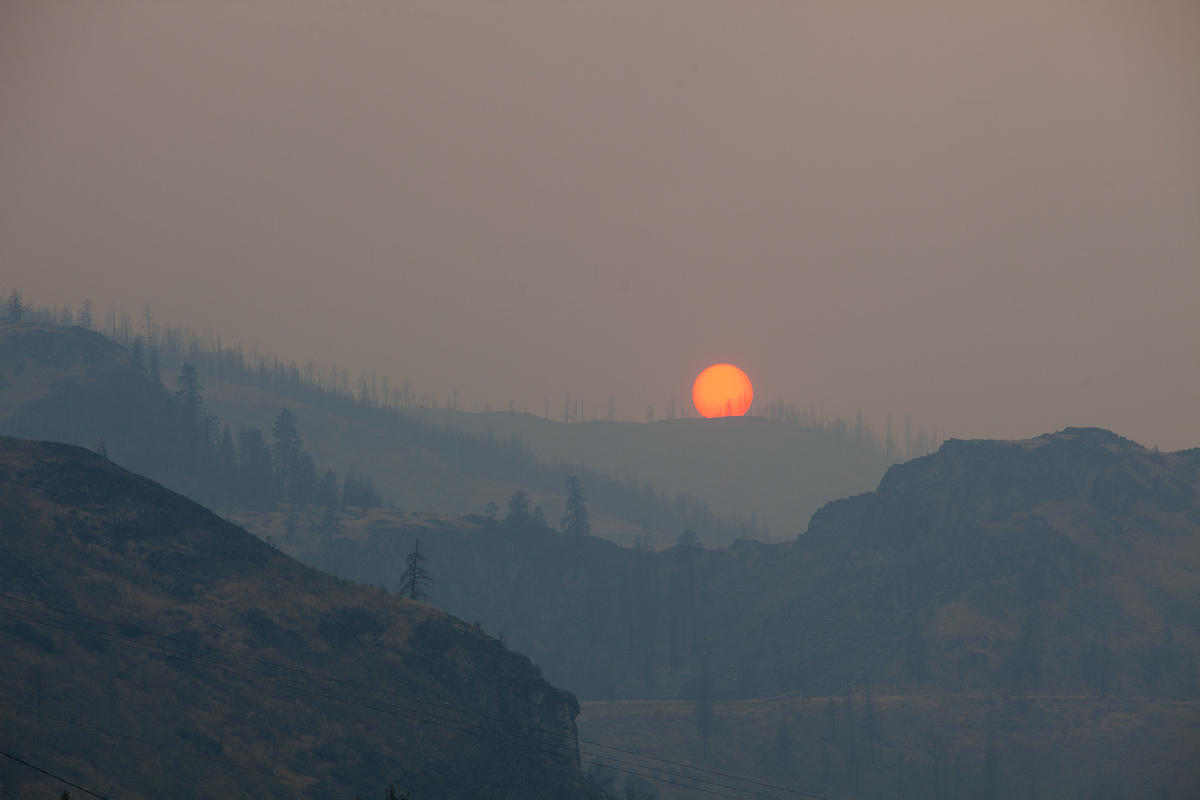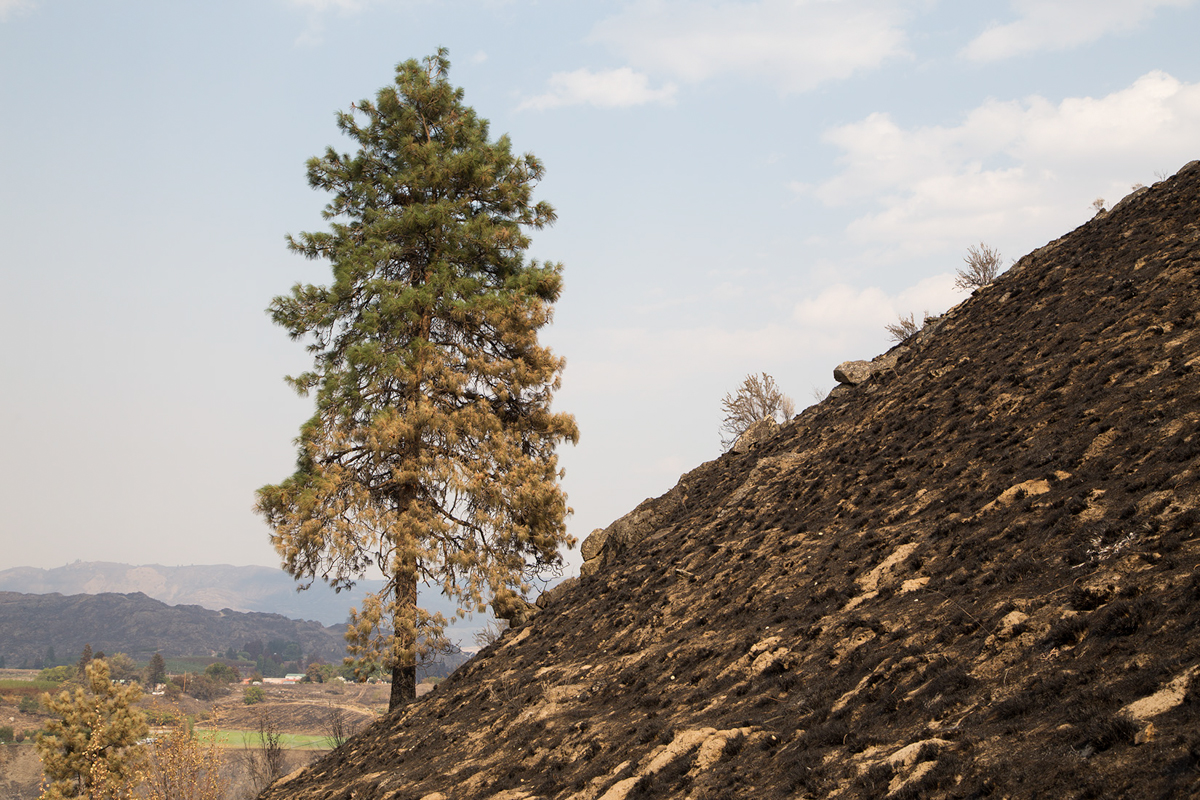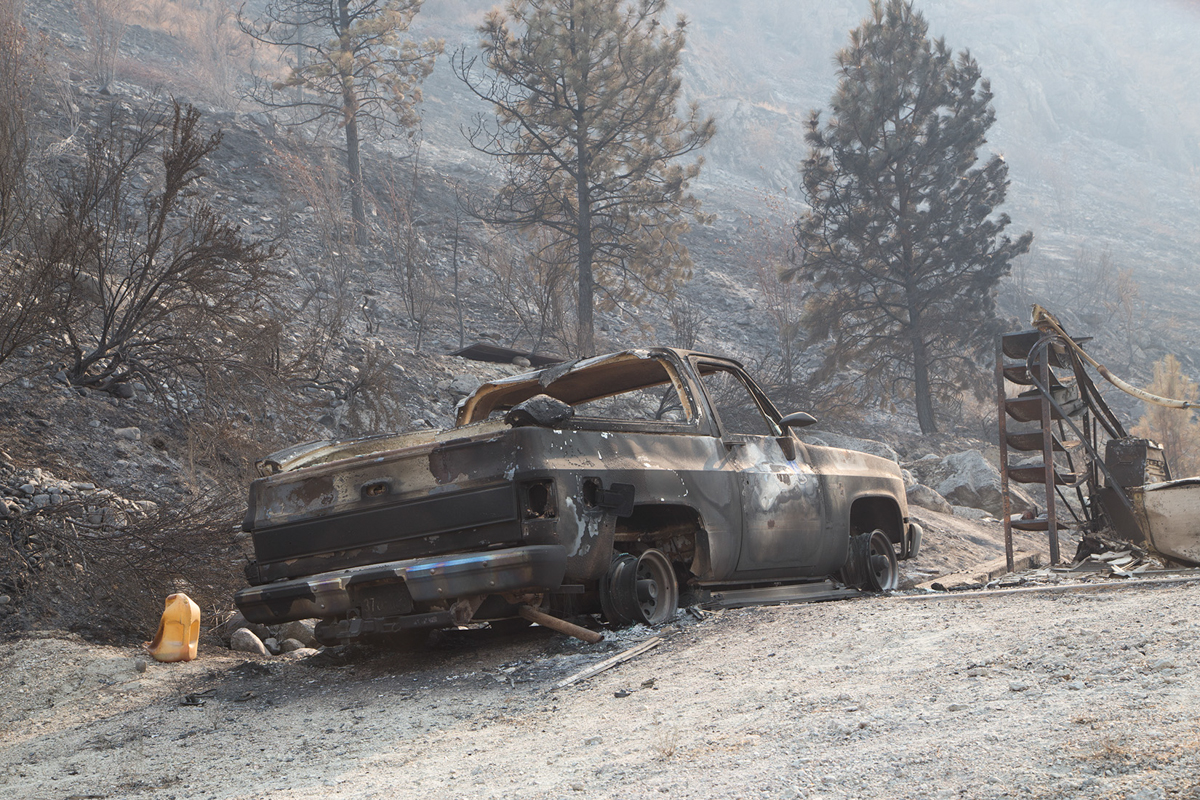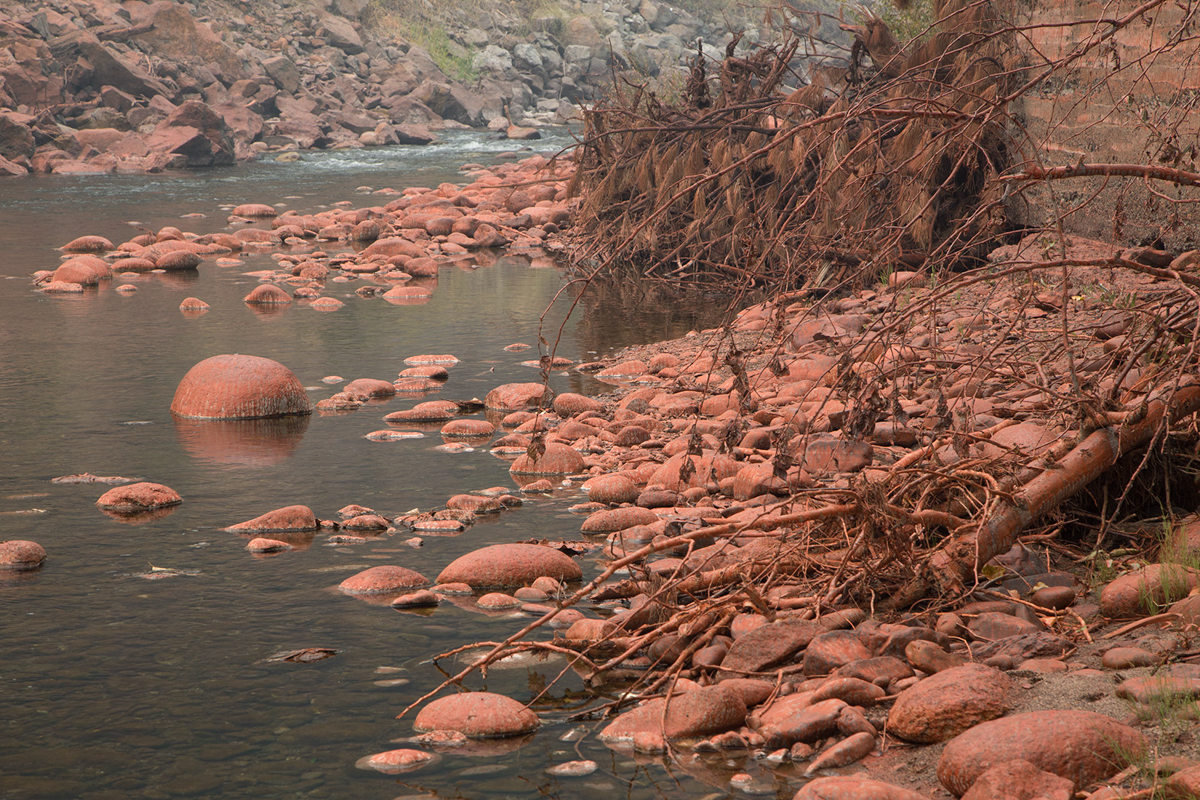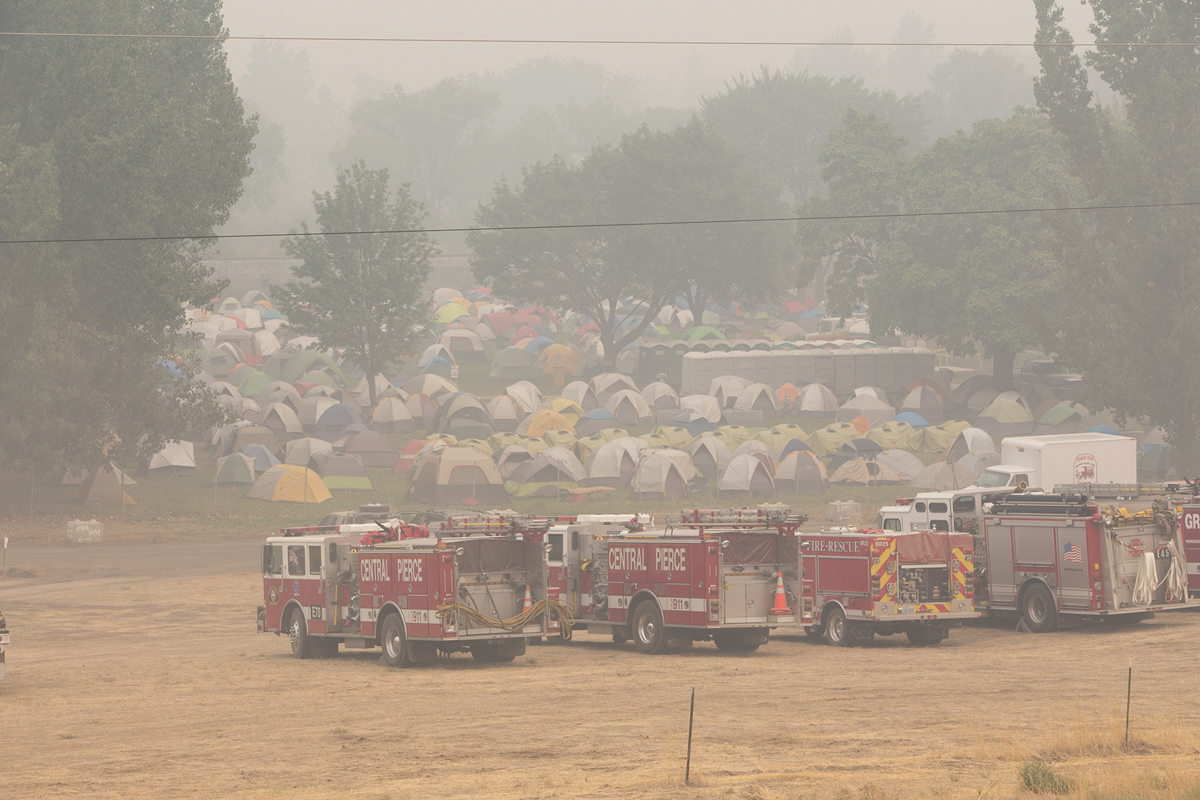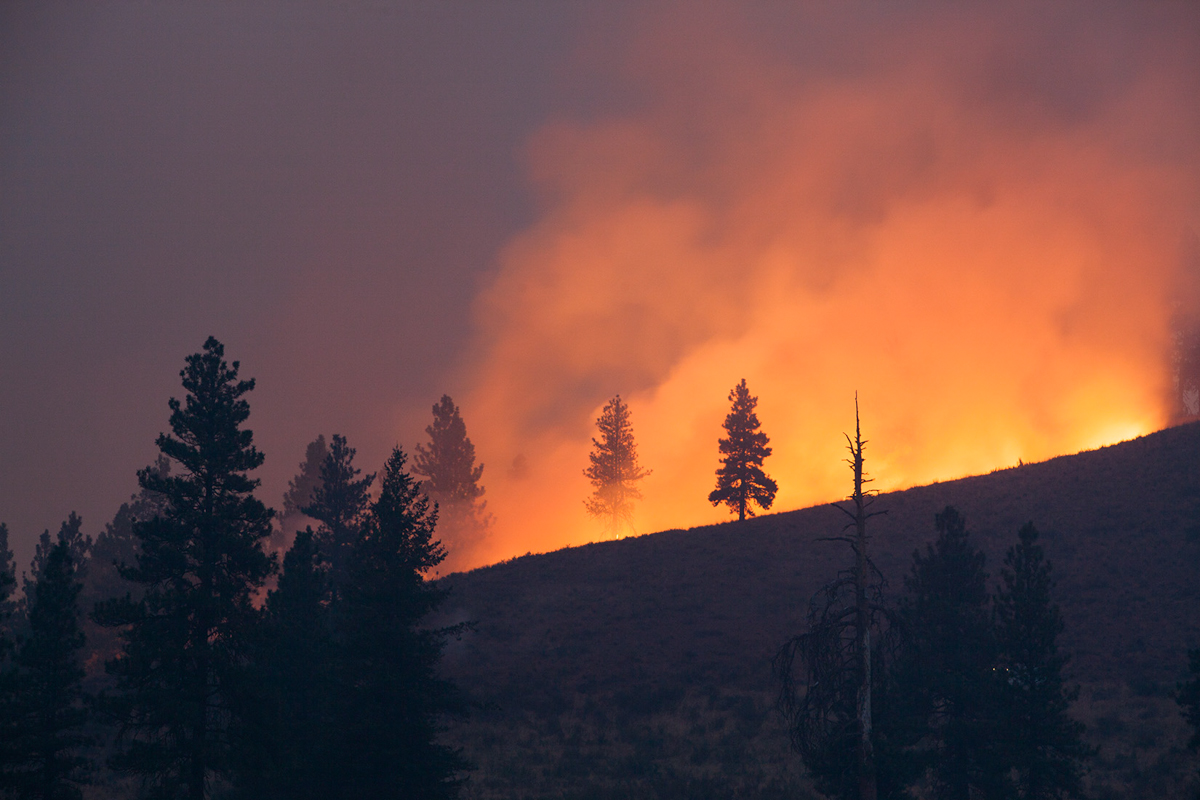Support the recovery of Washington’s shrub-steppe by adding your name to a letter to budget writers today!
Discovering Fire in our Forests
Written & Photographed by Brian Mize, Field Forester
Recently, I was traveling through our Central Cascades lands, noticed a strong odor and saw a small amount of smoke approximately 200’ off the road. I am very familiar with this particular location because it has been a popular spot with the local firewood poachers.
I hiked off the road and found a campfire that had escaped the ring and burned a small area. At that time, the fire was just smoldering and there was nobody around.
Acting quickly, I called the Central Washington Interagency Communication Center in Wenatchee, and they sent out the dispatch to any local fire engines. A Forest Service engine was the first to respond and arrived shortly after. They ran a quick hose line to the fire and extinguished all the heat and put a hand line around the burned area. Afterwards, a Dept. of Natural Resources engine arrived along with a DNR law enforcement officer.
This was clearly a human caused fire, but we did not find any evidence that could pinpoint any specific individuals. There was evidence of recent firewood theft in the immediate vicinity.
Overall, this ended up being a small incident; however, if I had not spotted this fire when I did, it could have developed into something greater in scope. This area is very brushy, steep, and the high temps that day were above 90 degrees. With a little wind, this fire had high potential for spread.
We love that we can provide as much access to the outdoors as possible to our local communities with our lands. It was a good reminder that although fire season has been off to a slow start this summer, we still have a long way to go.
Learn about Fire adapted Communities
Building Fire Resilient Communities with Networks
Written & Photographed by Reese Lolley, Director, Forest Restoration and Fire
Last week was the second annual Washington Fire Adapted Communities Learning Network communities and steering committee workshop! It was held in Wenatchee where seven communities shared their outcomes of being in the trenches for a year, and three new communities were brought on to learn about how Fire Adapted Communities provide a framework and approach to adapt to live in fire prone environments and reduce community risk.
There are three elements of being prepared and resilient to increasing amounts of fire predicted in Washington:
SUPPRESSION
To put unwanted fires out effectively to project people and places, and manage those that can have defined benefit.
While The Nature Conservancy does not have a large role , there is a nexus. Traditionally, the act of suppression has been the focus.
RESILIENT FORESTS
Greater than 2.7M acres of forests east of the Cascade crest are in need of active restoration (thinning and or controlled burning). Water, wildlife, and fire do not recognize ownership boundaries. Working in large watersheds, using strong restoration evidence base to set initial goals, collaboratives plan and coordinate projects leveraging resources across ownerships to increase pace and scale of outcomes having a collective positive impact.
FIRE ADAPTED COMMUNITIES (LEARNING NETWORK)
Empower people in communities to take action to prepare, reduce risk, share lessons learned and be resilient living in a fire environment. Learning Networks are developed to accelerate growth and develop innovations, to engage solutions for complex problems.
It's amazing what the local community along with partners and The Nature Conservancy have accomplished in three short years:
- Washington was the first National Fire Adapted Communities Learning Network member to expand to a statewide FAC network, which is now being replicated in other states.
- $500,000 invested by Bureau of Land Management into the state network.
- We have fostered organizational and fiscal capacity of the South Central Resource Conservation and Development Council for future management of this effort.
- We've engaged a WA-FAC steering committee of Federal, state, private, and NGO organizations that provide member communities with greater access to resources as well as facilitating understanding and sharing across and within organization silos of excellence (just recently brought on State Commerce).
- We have ten communities across the state that are taking a diverse set of actions that is reducing their wildfire risk, and sharing those lessons learned with each other with various tools within the network as well as sharing outside the network with other communities, including policy makers.
It is exciting to see these results not only making a difference in communities, but also for how this work indirectly supports our lands work in creating more resilient forest conditions for wildlife, water, and people.
From one Fire Chief engaged in WA-FAC-LN said, “there was no way a year ago I would of signed onto a letter to the Governor encouraging him to sign a Prescribed Fire Pilot Bill and exclaiming how important controlled burning is as a part of the soultion," but how excited he was do so recently, to a Northeast Washington home owner association member at last week’s meeting making a statement to the group that “in Washington we need to learn to live with fire, that by engaging communities and supporting their efforts in reducing risk, it will allow land managers to manage a lot more fire for multiple objectives that will in turn make forests more resilient and communities safer."
Changes in culture are hard to measure, while we are far from community members taking actions to prepare for fire being as normal as preparing for an earthquake in San Francisco or living in a flood zone, we are trending in the right direction!
This is a testament to what can be done with a little vision, leadership and developing and working with a network of committed partners!
LEARN MORE ABOUT THE WASHINGTON FIRE ADAPTED COMMUNITIES LEARNING NETWORK
Learn more about the National Fire Adapted Learning Nework (FAC-LN)
IN THE NEWS ON FIRE
Photography by John Marshall
Once again our state has set a grim record. For the second summer in a row, we are experiencing the largest wildfire in our state’s history. Nearly 1 million acres have burned, hundreds of homes have been lost, and, most devastating, three firefighters lost their lives fighting the blazes that blanket North Central Washington.
Read our Board Chair Byron Bishop’s guest opinion column about actions we can take now to reduce the threat. It appeared in the Seattle Times, Sunday, Sept. 6
The Conservancy has been advocating for and working on strategies to improve our resilience to these megafires.
Here’s a roundup of recent news coverage:
Seattle Times, Nov. 9: Legislature needs to provide the funding to pre-empt wildfires
Seattle Times editorial on the need for Legislative funding for fire solutions
Seattle Times, Nov. 9: Congress needs to address wildfires like any other disaster
Seattle Times editorial in support of the Wildfire Disaster Funding Act, which is a Nature Conservancy priority for Congress. It would bring funding stability to the Forest Service, which has to spend money designated for improvements on fighting fires.
KING-TV, Oct. 15: Forest restored to pre-wildfire condition
KING TV’s new environmental reporter, Alison Morrow, did a feature story on the collaborative restoration project at Oak Creek Wildlife Area, designed to make the forest more resilient in the face of wildfire.
Seattle Times, Oct. 11: Fighting Fire With Fire
Front-page storyon the importance of controlled burning in fighting wildfire, and the barriers to getting more done in Washington:
“We have a set of regulations that are fairly outdated,” said Reese Lolley, director of the Nature Conservancy’s Eastern Washington Forest Program. “More and more, I think we are looking at how do we better live with fire, and how do we use it as a tool.”
Our forest scientists played a critical role in helping the reporters develop the story.
The Olympian, Sept. 27: Dramatic climate shifts require attention to forests, water
Guest opinion column by Washington State Director Mike Stevens and Public Lands Commissioner Peter Goldmark.
Wenatchee World, Aug. 30: Preparing for the next megafire
“The federal and state agencies, local government, and stakeholders through groups like the Nature Conservancy and the North Central Washington Forest Health Collaborative, know what to do and are ready to go.”
Tri-City Herald, Aug. 28: Wildfires should have natural disaster status
“Federal Agencies have run short of wildfire suppression money eight times since 2002, according to The Nature Conservancy in Washington State.”
Seattle Times, Aug. 26: Why we have such large wildfires this summer
“Analysis by the Nature Conservancy and U.S. Forest Service found that about 30 percent (2.7 million acres) of Eastern Washington federal, state, tribal and private forestland needs some kind of thinning or treatment to reduce the risk of wildfire. That could include cutting smaller trees or using planned fires to thin the forest.”
Wenatchee World, Aug. 19: We burn, but we have initiative
“‘We need to be proactive in reducing these hazardous fuels,’ said Lloyd McGee of the Nature Conservancy. That requires controlled burns and mechanical treatment.”
Yakima Herald, Aug. 19: New tools needed to improve wildfire prevention
“Collaborative efforts between the state, the Forest Service and the Yakama Nation at thinning fuel and restoring forest health have reduced fire risks, said Mary Sutton Carruthers, coordinator of the Tapash Sustainable Forest Collaborative.”
Wenatchee World, Aug. 18: Leaders search for solutions for wildfire management
“‘We’re fighting a war. To win a war sometime we have to learn how to live with the enemy,’ said Lloyd McGee, Eastern Washington Forests Program manager for The Nature Conservancy.”
Yakima Herald, Aug. 6: Advocating for the Wildfire Disaster Funding Act
“‘We’re going to fight these fires and pay for them one way or another, but this sets up a more rational way of funding that doesn’t impact other programs,’ said Cathy Baker, governmental relations director for The Nature Conservancy in Washington. ‘We’re really pleased with the strong bipartisan support for solving this. They just haven’t gotten there yet.’”
IMAGES FROM THE FIRE LINE
Photography by John Marshall
The Washington wildfires have been a devastating tragedy for our state. Here are a few of the people and places impacted by fire.
Preparing for fire in Washington
How communities are working to increase their resilience in the face of fire.
Written and Photographed by Mary Sutton Carruthers, Tapash Collaborative Coordinator and Reese Lolley, Eastern WA Forests Program Director
We are in the midst of what is now the largest wildfire season on record in Washington with forecasts of dry lightning potentially igniting new fires. All corners of our state are burning or have burned this summer. Most residents have felt the effects of smoke and many are reeling from the destruction of personal property, and most devastating of all is the tragic injury and loss of life of those bravely protecting what we value. Washingtonians are realizing that there is a collective and individual responsibility to increase the resiliency of our communities, forests, grasslands, and our ability to proactively live with wildfire.
This type of disaster resilience is built at the community scale and with that in mind, The Nature Conservancy and its partners has supported the establishment of Fire Adapted Communities both regionally and nationally. From a homeowner clearing out brush around their house and making exterior improvements to resist fire, to county residents and organizations coming together to create a Community Wildfire Protection Plan, to county governments and builders working together to make homes safer and less likely to burn, to businesses developing disaster resilience plans, to state, federal, and private organizations working together to achieve landscape scale forest restoration, Fire Adapted Communities assume responsibility for living in a wildfire prone landscape by taking pro-active steps towards increasing resiliency before, during, and after a fire. While firefighters have an immensely important and sometimes dangerous role, individuals and communities can take responsibly and make investments before fires that make wildfire response safer and more effective.
Fire Adapted Communities also incorporate many existing programs to help residents better prepare for wildfire including the National Fire Protection Association’s Firewise Communities program and the International Association of Fire Chiefs Ready, Set, Go! program.
The Washington Fire Adapted Communities Learning Network (WAFAC) was launched earlier this year and provides member communities with resources to engage with other WAFAC participants so that they can share information, resources and lessons learned. Learning networks connect and support people and organizations that are leaders in their communities, passionate problem solvers and want to share what makes a difference with the goal of accelerating existing and developing new approaches to preparing before, during and after wildfire. Currently, the communities in Washington include Okanogan, Chelan- Leavenworth, Yakima, Kittitas, San Juan, and Lincoln counties, as well as the Flowery Trails Community Association in Stevens County and the Seattle City Light-Skagit Hydroelectric Project in Whatcom County. These communities are educating residents on what they can do to prepare for the inevitable wildfire. They are reaching out to builders, home owners associations, county commissioners, businesses, and insurance companies to spark the discussion about how to collaborate to increase resiliency, and they are engaging landowners over best management practices following wildfires.
This year, we grieve for the lives lost in the act of protecting us from wildfires. We are in shock that north central Washington is leading again with an unprecedented amount of wildfire. Fire has touched us all, from the Idaho border to shrub-steppe lands around Moses Coulee to the San Juan’s to the outskirts of the Hoh Rainforest, and in many places and communities in-between. The importance of working to make these great places and landscapes more resilient and neighboring communities safer have never been more apparent. The Nature Conservancy is leading these efforts by supporting Fire Learning Network, Fire Adapted Communities, Washington Fire Adapted Communities Learning Network and through their membership in forest collaboratives working to increase the pace and scale of large watershed restoration, and through their support of the Wildfire Disaster Funding Act.
While current trends and climate science indicate that wildfire season is lengthening and acres burned will continue to grow in orders of magnitude compared to last century, there are actions we can take to increase our resilience and reduce the costs to people and nature living in a landscape that is on fire. Let’s not wait this time. Read more about two solutions we believe can provide relief from the worst of today’s megafires: through funding & improving management.
Minimizing the Impact of Megafires: Funding and Improving Management
Two Strategies for Consideration at Senate Committee Hearing in Seattle
Written by Carrie Krueger, Director of Marketing
Photographed by John Marshall
As the Senate Energy and Natural Resources Committee meets in Seattle to examine this summer’s disastrous fires, The Nature Conservancy encourages the Committee to focus on two solutions the organization believes can provide relief from the worst of today’s megafires:
1. Support and fund the National Cohesive Wildland Fire Management Strategy: The Cohesive Strategy is the result of a five-year collaborative planning effort that aligns governments at all levels to help develop fire-adapted communities, resilient landscapes, and to improve wildfire operations. It provides an approved mechanism to get all layers of government working together, including cities, counties, states, Tribes and Federal Departments of Agriculture, Interior, Defense, and Homeland Security. The Cohesive Strategy works to:
- Manage vegetation and fuels through thinning and controlled burns;
- Protect homes, communities, and other assets;
- Manage human-caused ignitions
- Effectively and efficiently respond to fire.
2. Fix the way emergency firefighting is funded by passing a fire-funding solution such as the Wildfire Disaster Funding Act (WDFA): As the Forest Service and the Department of the Interior suppress the emergency fires, they have to dip into funds set aside for other projects—including some of those that can help reduce the risk of fires in the first place. This is different from how other natural disasters are paid for, such as hurricanes, tornadoes or floods. The Nature Conservancy encourages Congress to continue its work to find a bipartisan solution to fix the fire-funding problem, like the Wildfire Disaster Funding Act (WDFA) that creates a disaster funding process for emergency wildfires. WDFA has the support of hundreds of conservation, forestry, outdoor industry, sportsmen’s organizations and more.
“Today the Forest Service has already spent close to all of its firefighting budget for the year, so we know they will need to transfer money away from other programs soon—affecting programs that conserve the water, wildlife and wood resources our forests provide,” said Cecilia Clavet, Senior Policy Advisor at The Nature Conservancy. “We need a solution now to stop crippling the federal agencies managing our natural assets with disruptive funding shortfalls.”
“Climate change, drought, and insects and disease, and more people living closer to forests have created an urgent need for restoration,” said Mike Stevens, Washington State Director for The Nature Conservancy. “Only a commitment to restoration and the funding necessary to make it happen at scale can break the cycle of catastrophic fires that are taking such a tremendous toll on our state.”
America’s forests are the source of half our nation’s water; support one million forest product jobs; grow the largest and oldest trees in the world; are home to thousands of American wildlife species; and generate more than $14 billion of recreation and other economic activity on Forest Service lands alone.
Today these essential benefits are in jeopardy, due to the unhealthy state of our forests and the dangerous megafires that result from these conditions. For example:
- The U.S. Forest Service estimates more than 100,000 square miles of the forests they manage—an area bigger than Oregon—is now at risk for megafire.
- 55 years of records from the National Interagency Fire Center reveal that nine out of our 10 largest fire seasons have occurred after 2000, with three of our largest fire seasons coming since 2006.
- Since 2007, six states have experienced record-sized fires—Arizona, California, Georgia, Texas, New Mexico and Washington. New Mexico and Washington each broke their own records twice in this time period.
- Insurance experts estimate there are nearly 900,000 residential properties (worth a total of $237 billion) at “high” to “very high” risk of wildfire in 2015.





































